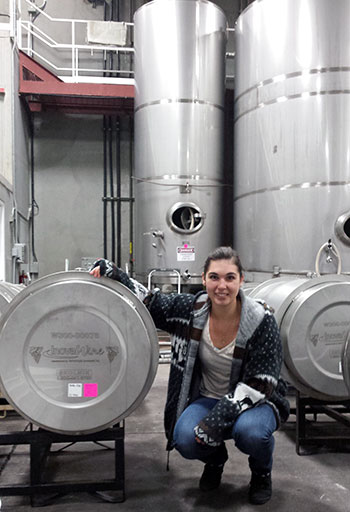UBC research shows different sulphite amounts affect yeast strain and final product
Adding different levels of sulphites to grape juice can significantly alter which yeasts are able to ferment the wine—and changes how the final wine tastes and smells.
UBC Okanagan PhD candidate Sydney Morgan has recently published research about how sulphites, also known as sulphur dioxide (SO2), affect wine yeast and how this reaction may change the taste of a product. After a six-month study at two different Okanagan wineries, Morgan has determined that different wine yeasts react differently to SO2 depending on how much was added at the beginning of fermentation.

UBC Okanagan PhD candidate Sydney Morgan conducts research on wine yeast strains and how they react to sulphites.
“We wanted to see whether adding different levels of sulphur dioxide at the beginning of the wine-making process changed the particular yeasts fermenting the grape juice,” she explains. “Because different yeast strains can produce different flavour and aroma compounds, this can significantly affect the flavour and aroma profile of the final wine.”
Her research—conducted with Assoc. Prof. of Biology Dan Durall—examined a common commercial yeast called Saccharomyces cerevisiae. While there are hundreds of strains of this yeast, adding different levels of SO2 can create different environments in the grape juice that allow different yeast strains to grow and take over fermentation. It is the yeast strain profile, or yeast composition, that helps determine the final taste of a wine.
Until recently, little was known about how different levels of SO2 at the early wine-making stage could create diverse environments that promote the growth of different yeast strains. Morgan chose two wineries for her study: Cedar Creek Estate Winery, an established business with a 40-year-old building, and 50th Parallel Estate Winery, a new winery with a recently completed wine-making facility. The wineries are significantly different—from the age of the buildings, to the grapes used, and geographical locations.
“The level of SO2 added before fermentation did specifically impact the dominant strains of yeast that we were able to identify throughout fermentation,” says Morgan. “The results of our research are of interest to both the scientific community as well as to wine makers who are looking to add lower levels of SO2 to their fermentations.”
Using sulphur dioxide in wine-making is considered essential by some, but it is also controversial, she explains. In low levels, sulphites are not harmful to most people, and they can help wine makers as they prevent spoilage, prevent the browning of white grape juice, and improve the longevity of wine. However, some people react to sulphites; some feel nausea, while others may have a red face, hives, and asthma sufferers may have a more severe response.
The research, partially funded by a grant from the BC Wine Grape Council and the Natural Sciences and Engineering Research Council of Canada, was recently published in the International Journal of Food Microbiology.
—30—
 Poll: Merger support rises
Poll: Merger support rises Wood pellet exports double
Wood pellet exports double Nearly $500K for car crash
Nearly $500K for car crash Minister defends right to bail
Minister defends right to bail Vise grips as steering wheel
Vise grips as steering wheel $36M for vaccine injury
$36M for vaccine injury  New US rules for airlines
New US rules for airlines  Historic Trump hearing
Historic Trump hearing  Pig kidney transplant
Pig kidney transplant  Big loss for Boeing
Big loss for Boeing  Metro sales edged higher
Metro sales edged higher Retail sales slip
Retail sales slip  Warriors snakebitten in loss
Warriors snakebitten in loss Iginla off to Europe
Iginla off to Europe Rockets ink prospect
Rockets ink prospect Perry teams with Lu Kala
Perry teams with Lu Kala Megan denies harassment
Megan denies harassment Swift ‘one of the family’
Swift ‘one of the family’



